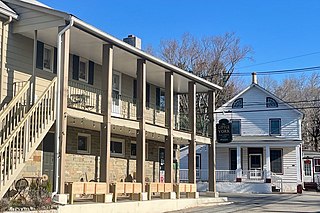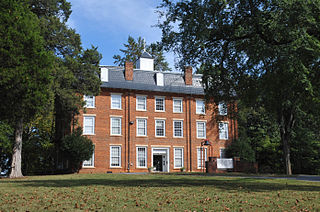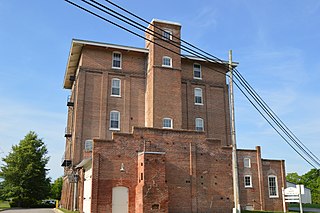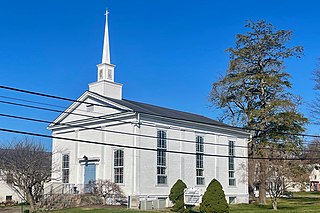
The Mount Pleasant Historic District is a national historic district that is located in Mount Pleasant, Westmoreland County, Pennsylvania.

Mooresville Historic District is a national historic district located in Mooresville, Iredell County, North Carolina. It encompasses 62 contributing buildings and 8 contributing sites in the central business district and surrounding residential sections of Mooresville. The district includes notable examples of Italianate, Romanesque Revival, and Renaissance Revival architecture. Notable buildings include the Mooresville depot, the former Lorene Cotton Seed Oil Mill, First Presbyterian Church (1899), McLelland House, D. E. Turner Hardware Co. store, the former U. S. Post Office, and the McKnight Pontiac-Buick Co..

Little York is an unincorporated community located along the border of Alexandria and Holland townships in Hunterdon County, in the U.S. state of New Jersey. Little York is located on County Route 614 3.1 miles (5.0 km) north-northeast of Milford. Little York has a post office with ZIP Code 08834.

Woodside Cotton Mill Village Historic District is a national historic district located in Greenville County, South Carolina. The district encompasses 278 contributing buildings and 2 contributing sites in an early 20th century urban South Carolina textile mill village. Centered on a mill founded by John T. Woodside in 1902, the district is located just west of the city limits of Greenville and is largely intact despite modernizations made by a succession of mill and home owners. The mill itself is a rectangular, brick, four-story building designed by J.E. Sirrine and built between 1902 and 1912. Eventually the mill became the largest cotton mill under one roof in the United States and one of the largest in the world.

Granby Mill Village Historic District is a national historic district located at Columbia, South Carolina. The district encompasses 97 contributing buildings associated with a cotton mill and associated mill village. The mill was initially constructed in 1896–1897, and is a large four-story, rectangular brick building in the Romanesque Revival style. It features two projecting five-story entrance towers. The Granby Mill Village includes a number of "saltbox" style dwellings reminiscent of a New England mill village. The district also includes the mill gatehouse, the two-story mill office building, commercial buildings, the Gothic Revival style Whaley Street Methodist Church, and operatives' houses.

Mount Pleasant Historic District is a national historic district located at Mount Pleasant, Charleston County, South Carolina. The district encompasses nine contributing buildings in the town of Mount Pleasant. The dwellings reflect Mount Pleasant's historic role as a summer resort town. The building reflect architectural styles of the 18th, 19th and early 20th centuries, including vernacular Georgian, Greek Revival and Gothic Revival. Notable buildings include the Mount Pleasant Presbyterian Church, St. Andrew's Episcopal Church, Mount Pleasant Seventh-Day Adventist Church, Hibben-McIver House, 200 Bank Street, and the Captain Peter Lewis House. Located in the district is the separately listed Old Courthouse.

Glencoe Mill Village Historic District is a national historic district located at Glencoe, Alamance County, North Carolina. It encompasses 48 contributing buildings and 6 contributing structures built between 1880 and 1882 in Glencoe.
Bost Mill Historic District is a national historic district located near Georgeville, Cabarrus County, North Carolina. The district encompasses 10 contributing buildings and 3 contributing sites associated with the Bost Mill grain and cotton operation. Notable buildings include the Bost Roller Mill, the John Bost House with its five outbuildings, the Bost Tenant House, the St. Paul's Methodist Church, and the Bost Cotton Gin.

Mount Pleasant Collegiate Institute Historic District is a national historic district located at Mount Pleasant, Cabarrus County, North Carolina. The district encompasses six contributing buildings associated with the Mount Pleasant Collegiate Institute, also known as Western Carolina Male Academy and North Carolina College. They are the three-story brick Main Building (1854-1855); Greek Revival style President's House; Matthias Barrier house; Society Hall; the Boarding House (1868); and the New Building (1925). The Western Carolina Male Academy was established in 1852 by the North Carolina Synod of the Evangelical Lutheran Church of America. The institute closed in 1933 after which, in 1941, the property was put up to auction. The Lentz Hotel was moved inside the district boundaries in 1980.

Edenton Cotton Mill Historic District is a national historic district located at Edenton, Chowan County, North Carolina. The district encompasses 70 contributing buildings, 1 contributing site, 2 contributing structures, and 1 contributing object in a small mill village. It includes industrial and residential buildings developed between 1899 and 1923. Residential buildings are primarily simple one-story, single-pile, frame dwellings and some examples of the Bungalow / American Craftsman style. Notable non-residential buildings include the Italianate Revival style Edenton Cotton Mill (1899-1916), Edenton Cotton Mill Office, and First Christian Church (1916).
Cooleemee Mill Town Historic District is a national historic district located at Cooleemee, Davie County, North Carolina. The district encompasses 433 contributing buildings, 1 contributing site, and 6 contributing structures on the original Cooleemee Cotton Mill Company property at Cooleemee. It was developed between 1898 and 1967, and includes notable examples of Gothic Revival, American Craftsman, and Colonial Revival style architecture. Notable contributing resources include the mill houses of 12 house types, Cooleemee Cotton Mill complex, Pest House and the company farm, Friendship Baptist Church, North Cooleemee Elementary School (1952), Church of the Good Shepherd (1925), Cooleemee United Methodist Church (1932), First Baptist Church of Cooleemee (1949), Cooleemee Recreation Center Bathhouse (1949), “The Holler,” and “Riverside Park,” also known as “Park Hill.”

West Durham Historic District is a national historic district located at Durham, Durham County, North Carolina. The district encompasses 101 contributing buildings in a mixed industrial, commercial, and residential section of Durham. The buildings primarily date after 1892 and include notable examples of Classical Revival, Italianate, and Queen Anne architecture. Located in the district is the separately listed Erwin Cotton Mills Company Mill No. 1 Headquarters Building. Other notable buildings include Erwin Cotton Mills Co. Mill No. 4 (1909–10), Erwin Cotton Mills Co. worker's housing (1910s), Fidelity Bank (1920s), E. K. Powe School (1928), Blacknall Memorial Presbyterian Church (1923), and St. Joseph's Episcopal Church.

Highland Cotton Mills Village Historic District is a historic mill village and national historic district located at High Point, Guilford County, North Carolina. The district encompasses 177 contributing buildings and 1 contributing structure. They include the two mills and the shipping and packing building at the Highland Cotton Mills, the Highland Cotton Mills Office, the Highland Methodist Church and its parsonage, the Johnson Farm House.

Mount Pleasant is an unincorporated community located along County Route 519 on the border of Alexandria Township and Holland Township, in Hunterdon County, New Jersey. The Mount Pleasant Historic District was listed on the National Register of Historic Places in 1987.

Hawkins Avenue Historic District is a national historic district located at Sanford, Lee County, North Carolina. It encompasses 200 contributing buildings and 4 contributing structures in a predominantly residential section of Sanford. The district includes notable examples of Colonial Revival and Queen Anne style architecture, with buildings largely dated between about 1900 to the 1930s. Located in the district is the separately listed Sanford High School, Former. Other notable buildings include the John McIver House (1880s), Duncan E. McIver House (1893), Malcolm D. McNeill House, E.L. Gavin House (1922), First Presbyterian Church of Sanford (1914), First Baptist Church (1925), the former Sanford Cotton Mill complex, and the Liles Bonded Cotton Warehouse.

Laboratory Historic District is a national historic district located at Laboratory, Lincoln County, North Carolina. It encompasses seven contributing buildings and two contributing structures associated with the Laboratory Cotton Mill and its founder and owner, Daniel E. Rhyne. They include the Laboratory Cotton Mill (1887), the Laboratory Cotton Mill Reservoir, the Daniel E. Rhyne House (1894), and the Federal / Greek Revival style Hoke-Rhyne House. The mill closed in the late 1990s.

Davidson Historic District is a national historic district located at Davidson, Mecklenburg County, North Carolina. The district encompasses 394 contributing buildings, 2 contributing sites, and 2 contributing structures in the central business district and surrounding residential neighborhoods of Davidson and campus of Davidson College. It was developed after 1837 and includes notable examples of Italianate, Greek Revival, and Gothic Revival style architecture. Located in the district are the separately listed Eumenean Hall and Philanthropic Hall. Other notable buildings include the Maxwell Chambers Building, Jackson Row (1928), Helper Hotel (1848), Johnston Grocery Store (1912), Southern Railway Depot (1897), Linden Cotton Factory (1890), Delburg Cotton Mills (1908), Davidson United Methodist Church (1908), Davidson College Presbyterian Church (1951), and Carnegie Library (1909).

Rocky Mount Mills Village Historic District is a national historic district located at Rocky Mount, Nash County, North Carolina. It encompasses 101 contributing buildings and 2 contributing structures in a historic mill village located at Rocky Mount. The buildings primarily date between about 1835 and 1948, and include notable examples of Greek Revival and Bungalow / American Craftsman style residential architecture. The district includes the buildings previously listed as Rocky Mount Mills and includes the Colonel Benjamin D. Battle House (1835). Other notable buildings include the mill village community house (1918) and a variety of one- and two-story frame mill worker houses.

Spray Industrial Historic District is a national historic district located at Eden, Rockingham County, North Carolina. It encompasses 70 contributing buildings, 9 contributing structures, and 1 contributing object in an industrial section of the town of Eden. It includes buildings associated with eight textile mill complexes, mill village housing, and seven commercial buildings. Notable contributing resources include the Smith River Dam and Spray Power canal, Morehead Cotton Mill complex, "Superintendent's" House, Imperial Bank and Trust Company (1912), Leaksville Cotton Mills complex, Spray Mercantile Building, Spray Cotton Mills complex, Lily Mill complex, Nantucket Mills complex designed by R. C. Biberstein, American Warehouse Company complex, Rhode Island Mill complex, Phillips-Chatham House, and Spray Woolen Mill complex.
Glen Royall Mill Village Historic District is a historic mill town and national historic district located at Wake Forest, Wake County, North Carolina. The district encompasses 82 contributing buildings and 1 contributing site built between about 1900 and 1949. It is located in a residential section of the town of Wake Forest. There are notable examples of Bungalow / American Craftsman style architecture. Located in the district is the separately listed Royall Cotton Mill Commissary. Other notable buildings include the Royall Cotton Mill (1899-1900), the Powell-White House (1909-1910), and pyramidal cottages, triple-A cottages, and shotgun houses.





















